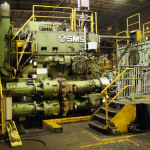
Modellierung, Optimierung und Qualitätsmonitoring für das Besäumen von Grobblechen
Projektschwerpunkte
- Untersuchung und Modellierung des Besäumprozesses von Grobblechen
- Optimierung des Prozesses und der Anlagenkonstruktion
- Ursachenforschung und Minimierung von Qualitätsmängeln
- Entwicklung eines kamera- und laserbasierten Systems zum Qualitätsmonitoring
Beschreibung
In der Metallindustrie bezeichnet Besäumen das möglichst rechteckige Zuschneiden von Grobblechen nach dem Walzvorgang. Rollschnittscheren (siehe Abb. 1) bewerkstelligen diese Aufgabe schrittweise und rein mechanisch mit rollenden Messern. Aufgrund der Blechdicken von bis zu 45mm entstehen dabei Prozesskräfte bis zu 5MN. Trotz der weiten Verbreitung von Besäumscheren treten häufig Qualitätsmängel an den Schnittkanten wie Ausbrüche, ungerade Kanten oder Schnittgrate auf. Zudem kann das Besäumen zu einer Abweichung von der idealen rechteckigen Walztafelkontur führen.

Prinzip des Rollschnittscherens zur Besäumung von Walztafeln.
Im Rahmen dieses Projekts wurde die seitliche Abdrängkraft, welche auf die Besäummesser wirkt, als wesentliche Einflussgröße auf die erzielte Qualität der Schnittkanten identifiziert. Ein Schwerpunkt dieser Arbeit liegt darin, diese Abdrängkraft durch Optimierung der Anlagengeometrie und der Antriebskinematik möglichst konstant zu halten und somit die Qualitätsmängel an der Schnittkante deutlich zu reduzieren. Zudem kann damit der Messerverschleiß verringert werden.
Ein weiterer Schwerpunkt dieser Arbeit liegt auf der Entwicklung einer automatisierten Qualitätskontrolle. Die Qualität und Maßgenauigkeit der Schnittkante wird mittels Bildverarbeitung und Laser-Sensorik automatisiert ausgewertet und in einer Datenbank abgelegt. Auf Basis dieser Daten werden Modelle und Algorithmen entwickelt, um eine gleichbleibend hohe Qualität der Schnittkanten zu gewährleisten, optimale Maschineneinstellungen zu berechnen und den optimalen Messerwechselzeitpunkt vorherzusagen.
Ausgewählte Veröffentlichungen
- A. Zeiler, A. Steinboeck, A. Kugi, and M. Jochum, Lateral Forces in Rolling-Cut Shearing and Their Consequences on Common Edge Defects, Journal of Manufacturing Science and Engineering, vol. 141, iss. 4, p. 41001-1–41001-9, 2019.
[BibTex] [Download]@Article{Zeiler2019, author = {Zeiler, A. and Steinboeck, A. and Kugi, A. and Jochum, M.}, title = {Lateral Forces in Rolling-Cut Shearing and Their Consequences on Common Edge Defects}, journal = {Journal of Manufacturing Science and Engineering}, year = {2019}, volume = {141}, number = {4}, pages = {41001-1--41001-9}, doi = {10.1115/1.4042578}, } - A. Zeiler, A. Steinboeck, M. Vincze, M. Jochum, and A. Kugi, Vision-based inspection and segmentation of trimmed steel edges, in Proceedings of the 18th IFAC Symposium on Control, Optimization and Automation in Mining, Mineral and Metal Processing, Stellenbosch, South Africa, 2019, p. 165–170.
[BibTex]@InProceedings{Zeiler2019a, author = {Zeiler, A. and Steinboeck, A. and Vincze, M. and Jochum, M. and Kugi, A.}, title = {Vision-based inspection and segmentation of trimmed steel edges}, booktitle = {Proceedings of the 18th IFAC Symposium on Control, Optimization and Automation in Mining, Mineral and Metal Processing}, year = {2019}, month = {8}, pages = {165--170}, doi = {10.1016/j.ifacol.2019.09.182}, address = {Stellenbosch, South Africa}, }
Anwendungsbereiche
- Scherprozesse
- Walzwerksautomatisierung
- Kontinuierliche Produktionsprozesse